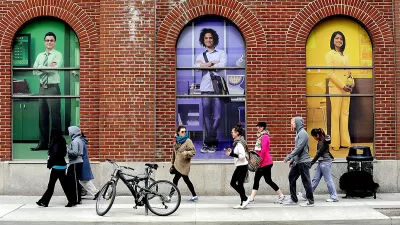An important new book, Healthy, Equitable Transportation Policy: Recommendations and Research, and its summary report, The Transportation Prescription: Bold New Ideas for Healthy, Equitable Transportation Reform in America, were just published by the Convergence Partnership, a coalition that supports more rational and equitable health policy.
An important new book, Healthy, Equitable Transportation Policy: Recommendations and Research, and its summary report, The Transportation Prescription: Bold New Ideas for Healthy, Equitable Transportation Reform in America, were just published by the Convergence Partnership, a coalition that supports more rational and equitable health policy.
I wrote the, "Public Transportation and Health" chapter. Some of the findings are amazing and have important implications for both healthcare and transportation policy debates. Public health impacts are not generally given a lot of consideration in transport planning decisions such as chosing between highway and public transit improvements, or whether to raise fuel taxes and parking fees, but this research suggests that creating a more diverse and efficient transport system may be among the most cost-effective ways to improve public health, and improving public health is one of the largest benefits of improving alternative modes (walking, cycling and public transit), encouraging more efficient travel patterns, and creating more accessible, multi-modal communities.
Let me provide evidence of these claims.
In 2006, the United States life expectancy averaged 78.1 years, eleven months less than the overall OECD average of 79.0 years, while the U.S. spends about twice as much on healthcare, both in absolute terms and as a portion of overall GDP. Although many factors contribute to this poor performance, a significant portion can be explained by automobile dependency and resulting high rates of per-capita vehicle travel in the U.S. Described more positively, many of the same "Win-Win" transportation policy reforms that reduce traffic congestion, road and parking costs, consumer costs, energy consumption and pollution emissions can also provide very large health benefits.
Although the U.S. has an average traffic fatality rate per vehicle-mile, it has the highest per capita traffic fatality rate in the OECD, due to high per capita annual mileage. According to the National Center for Injury Prevention and Control's Web-based Injury Statistics Query and Reporting System, traffic fatalities cause about 1.2 million potential years of life lost (PYLLs) annually in the U.S., which reduces average life expectancy by about five months. Reducing the U.S. per capita traffic fatality rates to the OECD average would add about three months to the average lifespan, as well as significantly reducing disabilities and healthcare costs.
International Traffic Fatalities (based on WHO and OECD data)

The US has the highest per capita traffic fatality rate among peer countries.
Vehicle air pollution probably causes a similar number of deaths and disabilities, although the victims tend to be older so there are probably fewer potential years of life lost and it is more difficult to predict how particular policy changes affect this risk.
Automobile dependency contributes significantly to sedentary living, obesity and associated health problems such as heart disease, stroke, hypertension and diabetes. A recent study titled "Walking, Cycling, and Obesity Rates in Europe, North America, and Australia," shows a strong positive correlation between automobile mode split and obesity (or put more positively, a strong correlation between transportation system diversity and healthy body mass). This study alone does not prove the point, but a significant amount of recent research shows that people who live in more walkable and transit-oriented communities are significantly more likely to achieve physical activity targets and avoid obesity than residents of automobile-dependent communities. In other words, we have a solution to some of the most difficult and costly health problems facing affluent countries in general, and the United States in particular.
Mode Split Versus National Obesity Rates (Bassett, et al 2008)

This and other data indicate that obesity rates are inversely related to use of alternative modes.
A more diverse and efficient transportation system can provide other health benefits. It provides consumer savings and affordability, so households have more money to spend on healthy food, medical services and other healthy activities. It also improves basic accessibility for non-drivers, allowing people who are physically and economically disadvantaged better access to medical services and affordable, healthy food. Improved walkability allows people to exercise more, which tends to improve mental health directly, and it tends to increase community cohesion (the quantity and quality of social interactions among neighbors), which tends to provide additional mental health benefits.
This suggests that shifting from current U.S. rates of traffic fatalities, vehicle pollution and physical activity to those of peer countries would increase average U.S. lifespans by at least six and possibly as much as twelve months, greatly reducing, and possibly eliminating, its relatively poor health outcomes, saving healthcare dollars and inceasing national economic productivity and competitiveness.
Here are a few other interesting findings from our research:
· Total traffic casualty rates tend to decline as walking, cycling and public transit travel increase in an area. Smart growth community residents have only about a quarter the per capita traffic fatality rate as residents of sprawled, automobile-dependent communities. All those families that moved to the suburbs for a safer place to raise their children were mistaken: taking into account all risks, urban communities are significantly healthier and safer overall than suburban and rural communities.
· Public transit reduces pollution emissions per passenger-mile, and transit-oriented development provides additional emission reductions by reducing per capita vehicle travel.
· U.S. Center for Disease Control recommends that adults average at least 22 daily minutes in moderate physical activity, such as brisk walking, to stay fit and healthy. Overall, less than half of American adults achieve this target, but most public transportation passengers achieve this target while walking to and from transit stations.
· Neighborhood design features affect public health. Of people with safe places to walk within ten minutes of home, 43% achieve recommended activity levels, compared with just 27% of unwalkable area residents.
· Physical inactivity contributes to numerous health problems, causing an estimated 200,000 annual deaths in the U.S. Annual medical expenditures of physically able adults averaged $1,019 if they are physically active and $1,349 if they are inactive, a 32% increase.
· Many physically and economically disadvantaged people depend on public transportation to access to medical services and obtain healthy, affordable food.
· Current demographic and economic trends are increasing demand for alternative modes. A growing portion of households would prefer to drive less and rely more on walking, cycling and public transit, provided these alternatives are convenient, comfortable, safe and affordable.
· Many transportation-related health impacts tend to be overlooked or undervalued in conventional planning. More comprehensive evaluation is needed to effectively integrate transportation and public health planning objectives.
This report is one in a growing body of research indicating that transportation and land use policy and planning reforms can really help make a community healthy, wealthy and wise.
For more information see:
Active Living Research (www.activelivingresearch.org) provides up-to-date information on research related to environmental factors that influence physical activity.
David Bassett, John Pucher, Ralph Buehler, Dixie L. Thompson, and Scott E. Crouter (2008), "Walking, Cycling, and Obesity Rates in Europe, North America, and Australia," Journal of Physical Activity and Health, Vol. 5 (www.humankinetics.com/jpah/journalAbout.cfm), pp. 795-814; at http://policy.rutgers.edu/faculty/pucher/JPAH08.pdf.
Judith Bell and Larry Cohen (2009), The Transportation Prescription: Bold New Ideas for Healthy, Equitable Transportation Reform in America, PolicyLink and the Prevention Institute Convergence Partnership (www.convergencepartnership.org/transportationhealthandequity).
Lilah M. Besser and Andrew L. Dannenberg (2005), "Walking to Public Transit: Steps to Help Meet Physical Activity Recommendations," American Journal of Preventive Medicine, Vo. 29, No. 4 (www.acpm.org); at www.cdc.gov/healthyplaces/articles/besser_dannenberg.pdf.
CDC (2009), Transportation and Health Toolkit, Healthy Eating Active Living Convergence Partnership, Center for Disease Control and Prevention (www.convergencepartnership.org/th101).
CFLRI (2009), Public Transit and Physical Activity: Lifestyle Tips, Canadian Fitness and Lifestyle Research Institute and ParticipACTION; at http://cflri.ca/eng/lifestyle/documents/LifestyleTips_Oct1_EN.pdf.
Peggy Edwards and Agis D. Tsouros (2008), A Healthy City Is An Active City: A Physical Activity Planning Guide, World Health Organization Europe (www.euro.who.int); at www.euro.who.int/InformationSources/Publications/Catalogue/20081103_1
Lawrence Frank, Sarah Kavage and Todd Litman (2006), Promoting Public Health Through Smart Growth: Building Healthier Communities Through Transportation And Land Use Policies, Smart Growth BC (www.smartgrowth.bc.ca); at www.vtpi.org/sgbc_health.pdf.
Todd Litman (2004), If Health Matters: Integrating Public Health Objectives into Transportation Decision-Making, Victoria Transport Policy Institute (www.vtpi.org); at www.vtpi.org/health.pdf.
Todd Litman and Steven Fitzroy (2006), Safe Travels: Evaluating Mobility Management Traffic Safety Benefits, Victoria Transport Policy Institute (www.vtpi.org); at www.vtpi.org/safetrav.pdf.
William H. Lucy (2003), "Mortality Risk Associated With Leaving Home: Recognizing the Relevance of the Built Environment," American Journal of Public Health, Vol. 93, No. 9, September 2003, pp. 1564-1569; at www.ajph.org/cgi/content/full/93/9/1564.
OECD (2009), OECD Health Data 2009: How Does the United States Compare, Organization for Economic Cooperation and Development (www.oecd.org); at www.oecd.org/dataoecd/46/2/38980580.pdf.
WHO (2004), World Report on Road Traffic Injury Prevention, World Health Organization and World Bank (www.who.int); at www.who.int/entity/world-health-day/2004/infomaterials/world_report.

Planetizen Federal Action Tracker
A weekly monitor of how Trump’s orders and actions are impacting planners and planning in America.

Restaurant Patios Were a Pandemic Win — Why Were They so Hard to Keep?
Social distancing requirements and changes in travel patterns prompted cities to pilot new uses for street and sidewalk space. Then it got complicated.

Maui's Vacation Rental Debate Turns Ugly
Verbal attacks, misinformation campaigns and fistfights plague a high-stakes debate to convert thousands of vacation rentals into long-term housing.

In California Battle of Housing vs. Environment, Housing Just Won
A new state law significantly limits the power of CEQA, an environmental review law that served as a powerful tool for blocking new development.

Boulder Eliminates Parking Minimums Citywide
Officials estimate the cost of building a single underground parking space at up to $100,000.

Orange County, Florida Adopts Largest US “Sprawl Repair” Code
The ‘Orange Code’ seeks to rectify decades of sprawl-inducing, car-oriented development.
Urban Design for Planners 1: Software Tools
This six-course series explores essential urban design concepts using open source software and equips planners with the tools they need to participate fully in the urban design process.
Planning for Universal Design
Learn the tools for implementing Universal Design in planning regulations.
Heyer Gruel & Associates PA
JM Goldson LLC
Custer County Colorado
City of Camden Redevelopment Agency
City of Astoria
Transportation Research & Education Center (TREC) at Portland State University
Camden Redevelopment Agency
City of Claremont
Municipality of Princeton (NJ)




























